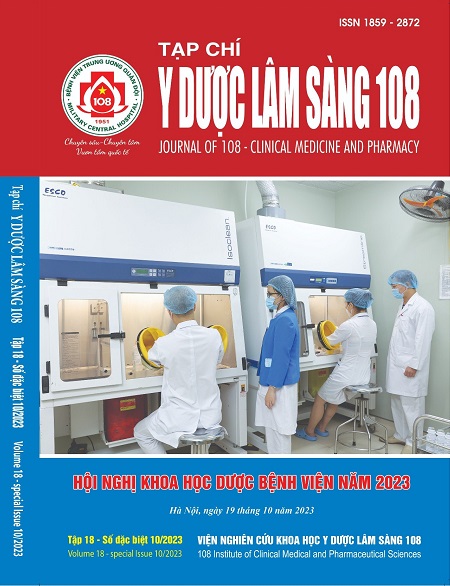Investigation on amikacin use at Intensive Care Units, 108 Military Central Hospital
Main Article Content
Keywords
Abstract
Objective: (1) To investigate characteristic of microbiological organisms and (2) to investigate amikacin dosage regimen and adverse drug events in the study patients. Subject and method: A cross-sectional retrospective study was conducted between January 2022 and May 2022 at ICUs 108 Military Central Hospital. Data was collected from patients’ medical profiles. Result: One hundred and twenty patients were included into the study, median age of patients is 74 years. Seventy-six patients received once-daily dosing (ODD) with the mean loading dose of 12.1 ± 2.8mg/kg. There were 16 patients with nephrotoxicity and 3 of them were indicated for dialysis. Conclusion: Amikacin dosage regimen in ICUs is lower than recommendation in guidelines. Amikacin is a drug with a narrow therapeutic range, it is necessary to amikacin therapeutic drug monitoring (TDM) and to adjust the dose according to the measured concentration values.
Article Details
References
2. Bệnh viện Trung ương Quân đội 108 (2021) Báo cáo tình hình vi khuẩn đề kháng kháng sinh năm 2021.
3. Taccone FS, Laterre PF, Spapen H et al (2010) Revisiting the loading dose of amikacin for patients with severe sepsis and septic shock. Critical Care 14(2).
4. Rodvold KA, George JM, Yoo L (2011) Penetration of antiinfective agents into pulmonary epithelial lining fluid: focus on antibacterial agents. Clin Pharmacokinet 50(10): 637-664.
5. Roberts JA, Abdul-Aziz MH, Lipman J et al (2014), Individualised antibiotic dosing for patients who are critically ill: Challenges and potential solutions. The Lancet Infectious Diseases 14(6): 498-509.
6. Vincent JL, Rello J, Marshall J et al (2009) International study of the prevalence and outcomes of infection in intensive care units. JAMA 302(21): 2323-2329.
7. Bassetti M, Luyt CE, Nicolau DP et al (2016) Characteristics of an ideal nebulized antibiotic for the treatment of pneumonia in the intubated patient. Annals of Intensive Care 6(1): 35-35.
8. Kalil AC, Metersky ML, Klompas M et al (2016) Management of adults with hospital-acquired and ventilator-associated pneumonia: 2016 clinical practice guidelines by the infectious diseases society of America and the american thoracic society. Clin Infect Dis 63(5): 61-111.
9. Niederman MS, Alder J, Bassetti M et al (2020) Inhaled amikacin adjunctive to intravenous standard-of-care antibiotics in mechanically ventilated patients with gram-negative pneumonia (INHALE): A double-blind, randomised, placebocontrolled, phase 3, superiority trial. The Lancet Infectious Diseases 20(3): 330-340.
10. Craig WA (2011) Optimizing aminoglycoside use. Crit Care Clin 27(1): 107-121.
11. Leggett JE (2015) Aminoglycosides. In: Bennett JE, Dolin R, Blaser MJ (Eds.) Mandell, Douglas, and Bennett's Principles and Practice of Infectious Diseases 8: 310-321.
12. Duszynska W, Taccone FS, Hurkacz M et al (2013) Therapeutic drug monitoring of amikacin in septic patients. Critical Care 17.
13. Oliveira JF, Silva CA, Barbieri CD et al (2009) Prevalence and risk factors for aminoglycoside nephrotoxicity in intensive care units. Antimicrob Agents Chemother 53(7): 2887-2891.
 ISSN: 1859 - 2872
ISSN: 1859 - 2872
